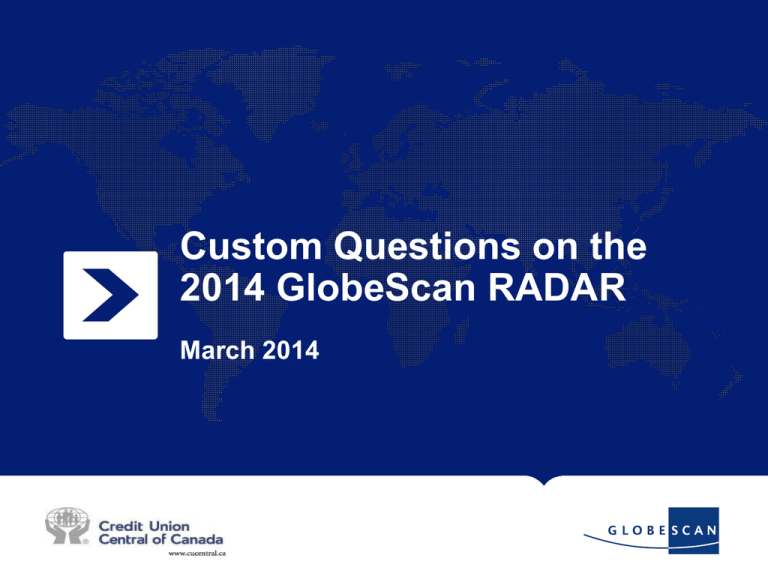2014 GlobeScan Radar Omnibus Survey CUCC
advertisement

Custom Questions on the 2014 GlobeScan RADAR March 2014 1 For more information, contact: Chris Coulter CEO Chris.Coulter@GlobeScan.com The research questions and results reported herein are provided on a confidential basis to Credit Union Central of Canada. CUCC is free to use the findings in whatever manner it chooses, including releasing them to the public or media. GlobeScan Incorporated subscribes to the standards of the World Association of Opinion and Marketing Research Professionals (ESOMAR). ESOMAR sets minimum disclosure standards for studies that are released to the public or the media. The purpose is to maintain the integrity of market research by avoiding misleading interpretations. If you are considering the dissemination of the findings, please consult with us regarding the form and content of publication. ESOMAR standards require us to correct any misinterpretation. Project: 3135, GlobeScan® April 2014 2 2 Notes to Reader 3 • Results are based on telephone interviews conducted among 1,000 adult respondents in Canada between January 10 and February 18, 2014. • Please note that all figures in the charts and tables included in this report are expressed in percentages unless otherwise indicated. Total percentages may not add to 100 because of rounding. Summary of Results 4 • Credit union customers tend to have the same top-of-mind concerns as other Canadians, although when prompted they rate poverty and the environment as more serious challenges (while being less concerned than others about a range of other issues). • Credit union customers strongly distrust global and national large companies; although all Canadians express negative net trust in business, credit union customers are far more distrustful than others. • Banks and financial services companies are also distrusted by credit union customers; more than half say they do not trust companies in this sector, compared to 35 percent of others saying the same. • Credit union customers are more likely than others to call for increased regulation of banks and financial services companies, in line with their distrust of the industry. • Credit union customers are slightly more likely to call for banks and financial institutions to reduce service charges and interest on loans, and to operate ethically, when asked what issues should be prioritized. • There are no differences between credit union customers and non-customers in terms of attitudes toward ethical consumerism. Most Important National Problem Unprompted, Credit Union Customers vs Non-Credit Union Customers, 2014 18 Economic problems 12 11 Environmental problems 12 12 Political problems Health issues / health care 7 Education 10 10 11 Unemployment Moral decay 22 5 1 2 Poverty/homelessness 1 Taxes 1 Credit union customers 3 6 Non-credit union customers 2 Q1t. What do you think is the most important problem facing our nation today? 5 Economic problems are top-ofmind for all Canadians, but credit union customers are slightly less likely than other Canadians to spontaneously mention the economy or poverty and homelessness when asked about the most important problem facing Canada. Seriousness of Challenges to Society “Very Serious,” Credit Union Customers vs Non-Credit Union Customers, 2014 Poverty/homelessness 48 Environmental pollution 49 Crime/violence 41 38 37 Education Online data security/privacy 47 34 Rising cost of food/energy 51 34 Lack of social security Unemployment 29 Economic problems/uncertainty 28 Human rights Economic inequality 15 23 43 When prompted to rate different challenges, however, credit union customers tend to rate poverty and homelessness, as well as environmental problems, as more serious than do others. However, this group tends to rate several other issues as significantly less serious than do non-credit union customers. 36 28 28 27 31 26 34 Violation of workers’ rights 6 55 54 52 49 48 Health care Gender inequality 56 39 Credit union customers Non-credit union customers Q3t. I am going to read you a list of possible challenges in our society. For each, please tell me how serious a challenge you think it is Trust in Companies Net Trust,* Credit Union Customers vs Non-Credit Union Customers, 2014 -15 Large national companies Global companies -1 -60 -19 Credit union customers Non-credit union customers Credit union customers are extremely distrustful of global companies, compared to the general population. This group also tends to distrust large Canadian companies. *Net trust equals “a lot of trust” and “some trust” minus “not much trust” and “no trust at all” 4t. Please tell me how much you trust each of the following institutions to operate in the best interest of our society. Would you say you have a lot of trust, some trust, not much trust, or no trust at all in…? 7 Trust in Banks and Financial Services Companies Credit Union Customers vs Non-Credit Union Customers, 2014 A lot of trust (5) Credit union customers Non-credit union customers 6 8 17 4 3 2 23 23 No trust at all (1) 34 34 DK/NA 19 21 1 14 Credit union customers are much more likely than others to say they do not trust banks and financial services institutions. 8t. Please tell me how much you trust each of the following types of companies. In answering, please use a scale from 1 to 5, where 1 is “no trust at all” and 5 is “a lot of trust.” How about [dt. Banks and financial services companies ]…? 8 Perceived Need for Regulation of the Banking / Financial Services Industry Credit Union Customers vs Non-Credit Union Customers 2014 Too much government regulation Credit union customers Non-credit union customers About the right amount of government regulation 5 7 Not enough government regulation 47 DK/NA 46 55 2 37 Consistent with their distrust of banks and financial services companies, Credit union customers are more likely than others to call for increased regulation of the industry. 9t. For each of the following types of companies, please tell me if you think our government does too much, about the right amount, or not enough in regulating their activities to ensure the health and safety of society. What about [dt Banks and financial services companies]…? 9 1 Most Important Issue the Banking / Financial Services Industry Needs to Address Credit Union Customers vs Non-Credit Union Customers 2014 Reducing service charges / high interest on loans 17 Operating ethically 12 Better customer service / online service 4 More loans/credit for small businesses / consumers Quality financial products/services 10 13 4 4 0 4 Credit union customers have similar priorities as other Canadians when asked what issues banks and financial institutions should address, although they are slightly more likely to call for reduced service charges and interest on loans, and ethical operations. Credit union customers are less likely than others to point to profits and greed as a key issue. 4 4 Responsible lending Regulation/restructuring/ surveillance of banking… Supporting charities/communities Low interest rates for deposits 16 6 6 Profits/greed 22 3 4 3 0 1 Credit union customers Non-credit union customers 5 13t. And what about the Banking/Financial Services industry – what is the most important issue it needs to address? Ethical Consumption “Strongly Agree,” 2014 Believe we need to consume less to preserve environment for future generations 66 65 Prefer to buy environmentally friendly products to ordinary ones 54 52 Encourage others to buy from socially/environmentally responsible companies 46 44 Willing to pay more for socially/environmentally responsible products 35 39 Think people exaggerate the seriousness of environmental problems 16 12 15 14 Feel guilty about my negative impact environment 13 14 Shopping for new things excites me Believe individuals cannot do much to save environment In order to be happy I need a lot of material possessions 11 Credit union customers and other Canadians exhibit very similar attitudes toward ethical consumption. 10 9 3 1 Credit union customers Non-credit union customers 28t. Please tell me if you strongly agree, somewhat agree, somewhat disagree, or strongly disagree with each of the following statements. Ethical Consumption: Segmentation Consumer segmentation, 2014 38 Aspirationals 42 45 Advocates Practicals Indifferents 12 40 10 6 Credit union customers 7 13 Non-credit union customers Credit union customers are more likely to fall into the Advocates or Practical segments , but are less likely to be Aspirationals or Indifferents. Appendix: Demographic Analysis 13 Summary of Results • More than one in ten Canadians (13%) use a credit union as their primary financial institution. • Canadians are more likely to be using a credit union as their primary financial institution than any other type of bank except chartered banks. • Credit union use is highest among: ‒ Those in Western Canada (and especially in Manitoba + Saskatchewan) ‒ Canadians with average levels of income ‒ Canadian females as opposed to males • Conversely, credit union use is lowest among: ‒ ‒ ‒ ‒ 14 Those in the Atlantic provinces and Ontario Young adults (18 to 24 year-olds) Canadians with the lowest levels of income Canadian males as opposed to females Type of Financial Institution Used for Day-to-Day Banking Needs 2014 Chartered banks 75 Credit unions 13 International banks 2 Internet-based 2 Virtual banks 2 Don't know / No answer While three-quarters of Canadians use a chartered bank as their primary financial institution, more than one in ten use credit unions primarily. 6 CU1. What type of financial institution do you primarily use for your day-to-day banking needs (chequing, deposits, bill payments, mortgage)? 15 Type of Financial Institution Used for Day-to-Day Banking Needs By Gender, 2014 78 Chartered banks 73 12 Credit unions Internet-based International banks Virtual banks Don't know / No answer 14 3 2 1 2 1 Male 2 Female 4 7 CU1. What type of financial institution do you primarily use for your day-to-day banking needs (chequing, deposits, bill payments, mortgage)? 16 Canadian women are slightly more likely than men to bank with credit unions. Canadian men are more likely than women to be using chartered banks. Credit Union Use by Age 2014 65 years+ 15 55 to 64 years 13 45 to 54 years 11 35 to 44 years 14 25 to 34 years 14 18 to 24 years There is no obvious trend in credit union use by age, though the youngest respondents are the least likely to bank with credit unions—they are the most likely age group to be using Internet-based banks. 10 CU1. What type of financial institution do you primarily use for your day-to-day banking needs (chequing, deposits, bill payments, mortgage)? 05 Credit Unions 17 Type of Financial Institution Used for Day-to-Day Banking Needs By Age, 2014 Chartered banks International banks Virtual banks Internetbased Credit unions 65 years+ 78 1 0 1 15 55 to 64 years 76 2 2 1 13 45 to 54 years 78 1 3 2 11 35 to 44 years 76 2 1 2 14 25 to 34 years 70 4 2 4 14 18 to 24 years 76 0 1 5 10 CU1. What type of financial institution do you primarily use for your day-to-day banking needs (chequing, deposits, bill payments, mortgage)? 18 Credit Union Use by Province/Region 2014 Prairies 30 Alberta 21 British Columbia 21 Quebec 10 Ontario Atlantic 8 Those in Western Canada are far more likely than those east of Manitoba to be using credit unions. Credit unions have particularly strong penetration in the Prairie provinces. 7 CU1. What type of financial institution do you primarily use for your day-to-day banking needs (chequing, deposits, bill payments, mortgage)? 05 Credit Unions 19 Type of Financial Institution Used for Day-to-Day Banking Needs By Province/Region, 2014 Chartered banks International banks Virtual banks Internetbased Credit unions British Columbia 67 4 1 3 21 Alberta 73 1 0 4 21 Prairies 60 0 2 3 30 Ontario 83 2 2 3 8 Quebec 74 0 1 1 10 Atlantic 80 5 3 1 7 CU1. What type of financial institution do you primarily use for your day-to-day banking needs (chequing, deposits, bill payments, mortgage)? 20 Credit Union Use by Income Level 2014 Very high 11 High 11 Average 21 Low Very low 11 Credit unions appear to appeal most to Canadians with average income levels. Average income respondents are the least likely income group to be using chartered banks. 8 CU1. What type of financial institution do you primarily use for your day-to-day banking needs (chequing, deposits, bill payments, mortgage)? 05 Credit Unions 21 Type of Financial Institution Used for Day-to-Day Banking Needs By Income Level, 2014 Chartered banks International banks Virtual banks Internetbased Credit unions Very high 76 2 2 8 11 High 78 2 3 4 11 Average 71 2 2 2 21 Low 80 0 1 1 11 Very low 85 1 1 0 8 CU1. What type of financial institution do you primarily use for your day-to-day banking needs (chequing, deposits, bill payments, mortgage)? 22 For twenty-five years, GlobeScan has helped clients measure, understand and build valuable relationships with their stakeholders, and to work collaboratively in delivering a sustainable and equitable future. Uniquely placed at the nexus of reputation, brand and sustainability, GlobeScan partners with clients to build trust, drive engagement and inspire innovation within, around and beyond their organizations. www.GlobeScan.com 23









